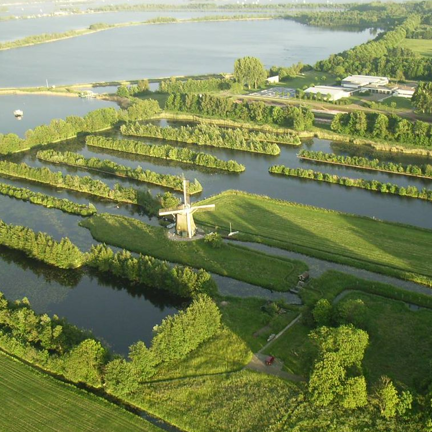- Homepage
- Get inspired
- Research & Innovation
Innovation for a resilient water future
At World Waternet, we are proud to be affiliated with Waternet, the public water cycle utility of Amsterdam and surroundings. Together we are preparing for the future with a strong research and innovation programme. By testing new technologies, improving operations, and responding to urgent social and environmental challenges, we are building knowledge that we share with water cycle companies worldwide.
Waternet's ambition: to create a climate-resilient, circular and data-driven water cycle that supports both people and nature.

Research topics
The Netherlands is already facing heavier rainfall, longer droughts and rising temperatures. By 2050 we aim to achieve a climate-resilient region with minimal disruption to daily life.
Focus areas
-
Smart water distribution and rainwater harvesting
-
Nature-based cooling in urban areas
-
Governance and planning for climate resilience
-
Protection against rising sea levels and fluctuating groundwater
Example projects
- Rainwater infiltration systems - monitoring and testing.
- CitySports - blue-green artificial grass to collect rainwater and naturally cooled grass.
- The Climate Cube - green oasis in a city shopping center.
- Transpiration from trees in the city.
- TKI Bellissima - Organic micropollutants in wastewater.
Clean water is the foundation of life. Yet pharmaceuticals, plastics, nutrients and pesticides threaten water quality and biodiversity.
Focus areas
-
Advanced treatment to remove medicine residues and micropollutants
-
Reuse of treated effluent for industrial water
-
Phosphorus recovery and circular use of nutrients
-
Protecting ecosystems through better monitoring
Example projects
- Taming brackish seepage: In the Horstermeerpolder, Waternet is investigating whether it is possible to pump up the brackish groundwater from the polder before it comes to the surface as seepage water. It is also being examined whether the pumped water can be purified into drinking water.
- Removing medicine residues from wastewater: The pilot study O3-STEP® was started at the sewage treatment plant (WWTP) Horstermeer. It is a study into the removal of medicine residues from wastewater.
- PathoCERT: Measurement methods and (attack) strategies are therefore being developed within the EU project Pathocert for pathogen-related risks faced by first responders.
- Bubble barrier against plastic: The bubble barrier is created by placing a tube at the bottom of the watercourse and pumping air through it. Both ships and fish can pass through a screen of air, but plastic is stopped.
- Slow sand filtration: Slow sand filtration is used as the last step in the drinking water purification process. It provides hygienically reliable and biologically stable drinking water.
The water cycle can be a powerful source of renewable energy. Aquathermal energy (ATE) – extracting heat and cold from surface, wastewater and drinking water – can replace natural gas and support local heat networks.
Focus areas
-
Aquathermal pilots in lakes and canals
-
Low-temperature district heating
-
Power-to-X technologies: turning renewable electricity into hydrogen, heat or demineralised water
Example projects
- Environmental heat map: Waternet's environmental heat map contains information on sources for aquathermy, heat demand, storage capacity of the soil and the construction year of houses.
- From sand extraction to heat extraction: Improving the water quality of Lake Sloterplas while using the lake to generate sustainable heat from the surrounding households.
- Power to the X - convert electricity in other energy products: Storing sustainably generated electricity and rainwater and/or converting it into the following products hydrogen, heat or demineralised water.
- Tomahawk II - software for realizing cooled heat networks.
- New Sanitation: Together with Waternet, the municipality of Amsterdam is working on the design of Strandeiland, a new island in IJburg where about 8,000 homes will be built in a highly sustainable way and the 'new sanitation' concept will be be applied.
By 2050, the Netherlands aims to run on 100% circular resources. Waternet is reducing the use of primary raw materials and reusing valuable by-products.
Focus areas
-
Life cycle assessments of materials and waste flows
-
Turning sewage sludge and urine into fertiliser
-
Designing circular pumping stations and treatment plants
Example projects
- Materials research for circular asset management.
- Circular dredging: a STOWA project that examines how water authorities can apply regional dredging spoil as efficiently as possible.
- New Sanitation project - Buiksloterham.
- Circular pumping station: Waternet has more than 800 pumping stations. Renovation or newly building them is a great opportunity to make them more sustainable.
- FosVaatje - urine as fertilizer.
Digitisation is transforming the water sector. Smart sensors, artificial intelligence and citizen science help us make data-driven decisions that improve efficiency and service.
Focus areas
-
Real-time groundwater and water quality monitoring
-
AI for smarter customer service
-
Robotics and drones for inspections
-
Citizen science for broader engagement
Example projects
- The hydrogen drone - fly longer with more sensors.
- The wastewater research street: here we introduce and test sensors, data-driven controls and decision support based on artificial intelligence.
- The Digital Canal: a dashboard with information collected by sensors and smart cameras about Amsterdam's water traffic.
- Smart water meters.
- Emily the sailing drone to detect rubbish in the canals.
Peatland subsidence is a major challenge in the Netherlands, causing damage to buildings and infrastructure while releasing greenhouse gases.
Focus areas
-
Groundwater management to reduce peat oxidation
-
Pilot projects with wet crops and circular agriculture
-
Carbon credit systems to fund peatland restoration
Example projects
- Wet crops pilot project: a land use method to reduce CO2 emission levels from peat and to stop soil subsidence.
- RE:PEAT - from interactive planning to integrated research: an interactive simulation platform that can be used to explore future scenarios in the peat meadow area.
- Green Deal carbon market - Currency for Peat: a 'carbon credit' project.
- The water level emissions estimator: an extra calculation step in groundwater modeling leading to better water level management decisions.
- Pilot polder circular agriculture.